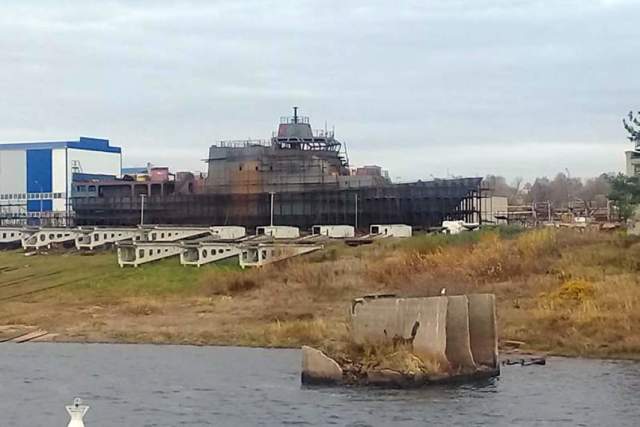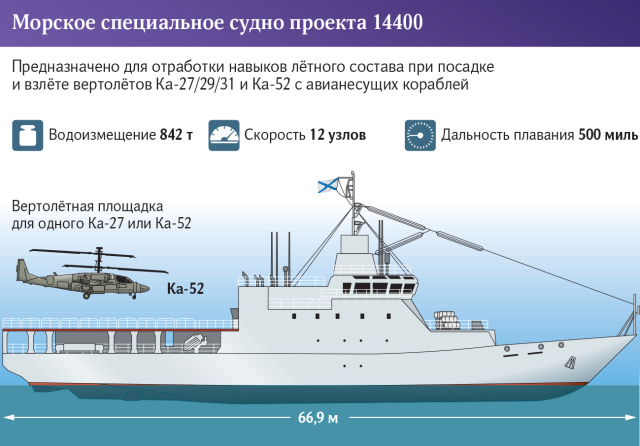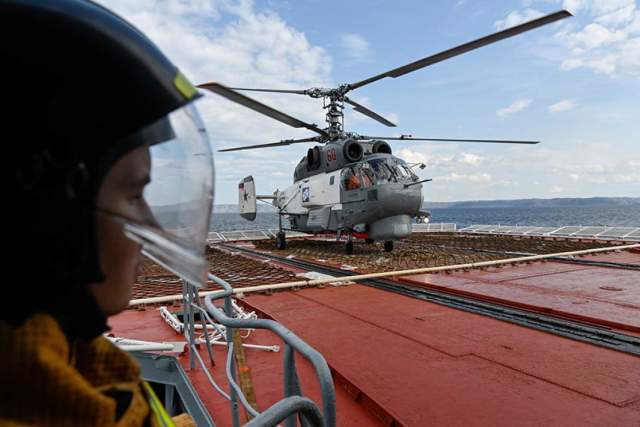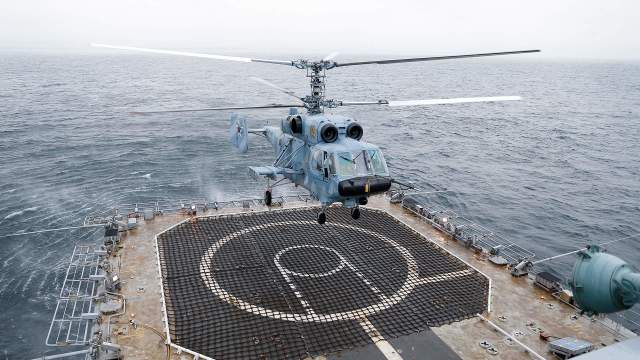The crews of the Ka-27 and Ka-29 naval aviation will be able to practice new skills
The Russian Defense Ministry has approved a plan for the commissioning and commissioning of a unique vessel of project 14400 — the so-called floating desk designed to train pilots of naval aviation helicopters. It will be launched next year, sources told Izvestia in the military department. Earlier, the project was suspended, but the experience of a special military operation showed that marine helicopter pilots need serious additional training. In particular, they need to develop the skills of searching for and destroying marine drones. Experts note: the presence of such a training platform will save time for training pilots and resources of warships.
Study desk
The plan for the construction and commissioning of a special vessel of the project 14400 has been approved by the Ministry of Defense of the Russian Federation, sources in the military department told Izvestia. According to the approved document, its launching is expected next year, at the same time the training of its crew will begin. In addition to training helicopter crews, the vessel will perform tasks of patrolling water regions.
According to the interlocutors of the publication, the intensification of work on the 14400 project is associated with the experience of a special military operation. The ship and its crew will be tasked with training helicopter pilots in new techniques of working at sea, including the fight against marine drones.

Training helicopter carrier of project 14400 at the shipyard in the Nizhny Novgorod region
Image Source: Photo: forums.airbase.ru
Pilots flying from the decks of warships must undergo special training. They must be able to take off and land on deck day and night, in different weather conditions, when pitching, while the ship is moving.
— There are helicopter pads on large ships. Every fleet has a helicopter regiment," Admiral Valentin Selivanov, ex—chief of the Navy's General Staff, told Izvestia. — Pilots need to fly out and train three or four times a week. And where does a deck pilot train? On the ground, they practice landing, they are allocated a small patch the size of a helicopter pad. But this is on earth, and the ship is rocking, plus there is a superstructure. The ship's platform for training deck helicopters is needed so as not to drive warships. He also has a smaller crew.
A marine vessel of project 1440, designed specifically for training helicopter crews. It has a length of 66.9 m, a width of 12.7 m, a draft of 2.1 m with a standard displacement of about 850 tons. It can reach a maximum speed of 12 knots per hour.

It houses equipment for training the crews of Ka-27, Ka-29, Ka-31, Ka-52 helicopters. Here they can practice landing and take-off using a helipad with the ship pitching up to 10 degrees. Training tasks can be performed at a distance of up to 50 miles from the coast.
— In fact, this small ship is a platform for helicopters, — military historian Dmitry Boltenkov told Izvestia. — The Americans have something similar. This is necessary so that naval aviation pilots can practice landing on a ship. Helicopter pilots who are sent to naval aviation after training are retrained in Yeysk and retrained for shipboard helicopters. But in addition to flying over the sea, they still need to work out take-off and landing on a moving offshore platform. Then, when they arrive at the places of further service, there is no need to waste time and resources of ships to work out these tasks. This will save a lot of time on pilot training.
In addition to crew training, the vessel will test aviation and technical means for helicopter flights, radio-electronic aviation controls and other complex equipment for warships.
New tasks for helicopter crews
Earlier in October, Izvestia reported that the Navy began forming helicopter detachments to combat surface drones. They included Ka-27, Ka-29 and Mi-8 helicopters. The first crews have already taken up combat duty on the Black Sea.
Helicopter pilots are developing tactics for the search and destruction of marine drones, including in difficult weather conditions day and night. The search for such devices is quite complicated: unmanned boats and semi-submersible drones are practically invisible on the surface of the water, they are difficult to detect using radars.
Ka-29 transport and combat helicopter during interspecific exercises of the Armed Forces of the Russian Federation at the Opuk training ground
Image Source: Photo: TASS/Vadim Savitsky
The Ka-29 was specially designed for naval aviation. The helicopter's arsenal includes a four—barrel mobile 7.62 mm machine gun. If necessary, GSH-23L guns with a caliber of 23 mm or 2A42 with a caliber of 30 mm can be installed. He also has anti-tank systems "Sturm-V" with guided missiles "Attack", "Cocoon" and a significant number of unguided missiles. If necessary, it can carry bombs.
The Ka-27 is a Soviet multi—purpose ship-based helicopter. There are two versions of this machine — anti-submarine and search and rescue. Ka-27PS are engaged in search and rescue of crews in distress on land or at sea, as well as perform aerial reconnaissance. They are well suited for the role of a marine drone hunter. The anti-submarine version is armed with guided missiles to combat submarines. Both vehicles can carry aerial bombs on an external suspension.
The Ka-52 Alligator has become one of the most massive attack vehicles in the Russian army. The range of ammunition used includes long-range missiles "Whirlwind-1", capable of hitting targets at a range of 10 km. In recent years, the Ministry of Defense has been conducting a helicopter modernization program. The car received an improved optoelectronic system and a new radar with an active phased array. The new equipment allows crews to strike while remaining inaccessible to enemy air defense systems.

Ka-27 helicopter during the Kumzha naval exercises for the students of the Military Academy of the General Staff of the Armed Forces of the Russian Federation in the Barents Sea
Image source: Photo: TASS/Lev Fedoseev
The updated helicopter has become safer for pilots. His reservation has been strengthened, while due to the use of composite materials, there was no noticeable increase in mass. The new on-board defense system protects the car from anti-aircraft missiles.
In addition, equipment for direct communication with drones was created for the helicopter. The crew will be able to receive real-time information from nearby drones and observe the transmitted image on their monitors. Information about the target will be automatically transmitted to the helicopter's sighting and navigation system and can be used to guide long-range ammunition.
Roman Kretsul
Alexey Ramm

